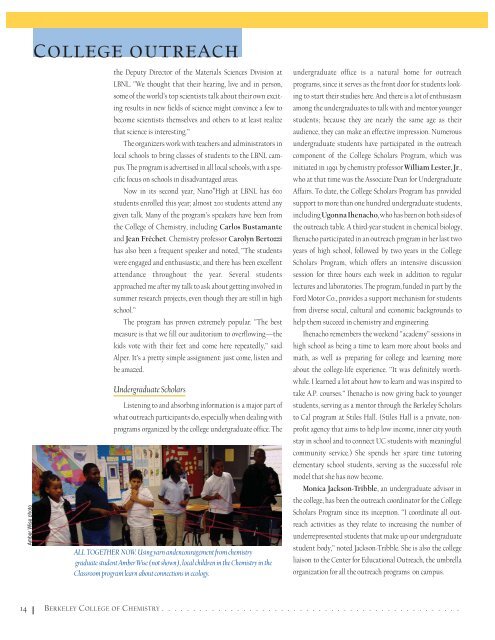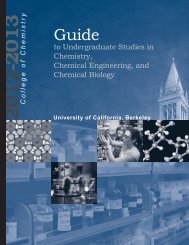Newsjournal body.qxp - College of Chemistry - University of ...
Newsjournal body.qxp - College of Chemistry - University of ...
Newsjournal body.qxp - College of Chemistry - University of ...
You also want an ePaper? Increase the reach of your titles
YUMPU automatically turns print PDFs into web optimized ePapers that Google loves.
Amber Wise photo <strong>College</strong> outreach<br />
the Deputy Director <strong>of</strong> the Materials Sciences Division at<br />
LBNL. “We thought that their hearing, live and in person,<br />
some <strong>of</strong> the world’s top scientists talk about their own exciting<br />
results in new fields <strong>of</strong> science might convince a few to<br />
become scientists themselves and others to at least realize<br />
that science is interesting.”<br />
The organizers work with teachers and administrators in<br />
local schools to bring classes <strong>of</strong> students to the LBNL campus.<br />
The program is advertised in all local schools, with a specific<br />
focus on schools in disadvantaged areas.<br />
Now in its second year, Nano*High at LBNL has 600<br />
students enrolled this year; almost 200 students attend any<br />
given talk. Many <strong>of</strong> the program’s speakers have been from<br />
the <strong>College</strong> <strong>of</strong> <strong>Chemistry</strong>, including Carlos Bustamante<br />
and Jean Fréchet. <strong>Chemistry</strong> pr<strong>of</strong>essor Carolyn Bertozzi<br />
has also been a frequent speaker and noted, “The students<br />
were engaged and enthusiastic, and there has been excellent<br />
attendance throughout the year. Several students<br />
approached me after my talk to ask about getting involved in<br />
summer research projects, even though they are still in high<br />
school.”<br />
The program has proven extremely popular. “The best<br />
measure is that we fill our auditorium to overflowing—the<br />
kids vote with their feet and come here repeatedly,” said<br />
Alper. It’s a pretty simple assignment: just come, listen and<br />
be amazed.<br />
Undergraduate Scholars<br />
Listening to and absorbing information is a major part <strong>of</strong><br />
what outreach participants do, especially when dealing with<br />
programs organized by the college undergraduate <strong>of</strong>fice. The<br />
ALL TOGETHER NOW. Using yarn andencouragement from chemistry<br />
graduate student Amber Wise (not shown), local children in the <strong>Chemistry</strong> in the<br />
Classroom program learn about connections in ecology.<br />
undergraduate <strong>of</strong>fice is a natural home for outreach<br />
programs, since it serves as the front door for students looking<br />
to start their studies here. And there is a lot <strong>of</strong> enthusiasm<br />
among the undergraduates to talk with and mentor younger<br />
students; because they are nearly the same age as their<br />
audience, they can make an effective impression. Numerous<br />
undergraduate students have participated in the outreach<br />
component <strong>of</strong> the <strong>College</strong> Scholars Program, which was<br />
initiated in 1991 by chemistry pr<strong>of</strong>essor William Lester, Jr.,<br />
who at that time was the Associate Dean for Undergraduate<br />
Affairs. To date, the <strong>College</strong> Scholars Program has provided<br />
support to more than one hundred undergraduate students,<br />
including Ugonna Ihenacho, who has been on both sides <strong>of</strong><br />
the outreach table. A third-year student in chemical biology,<br />
Ihenacho participated in an outreach program in her last two<br />
years <strong>of</strong> high school, followed by two years in the <strong>College</strong><br />
Scholars Program, which <strong>of</strong>fers an intensive discussion<br />
session for three hours each week in addition to regular<br />
lectures and laboratories. The program, funded in part by the<br />
Ford Motor Co., provides a support mechanism for students<br />
from diverse social, cultural and economic backgrounds to<br />
help them succeed in chemistry and engineering.<br />
Ihenacho remembers the weekend “academy” sessions in<br />
high school as being a time to learn more about books and<br />
math, as well as preparing for college and learning more<br />
about the college-life experience. “It was definitely worthwhile.<br />
I learned a lot about how to learn and was inspired to<br />
take A.P. courses.” Ihenacho is now giving back to younger<br />
students, serving as a mentor through the Berkeley Scholars<br />
to Cal program at Stiles Hall. (Stiles Hall is a private, nonpr<strong>of</strong>it<br />
agency that aims to help low income, inner city youth<br />
stay in school and to connect UC students with meaningful<br />
community service.) She spends her spare time tutoring<br />
elementary school students, serving as the successful role<br />
model that she has now become.<br />
Monica Jackson-Tribble, an undergraduate advisor in<br />
the college, has been the outreach coordinator for the <strong>College</strong><br />
Scholars Program since its inception. “I coordinate all outreach<br />
activities as they relate to increasing the number <strong>of</strong><br />
underrepresented students that make up our undergraduate<br />
student <strong>body</strong>,” noted Jackson-Tribble. She is also the college<br />
liaison to the Center for Educational Outreach, the umbrella<br />
organization for all the outreach programs on campus.<br />
14 BERKELEY COLLEGE OF CHEMISTRY . . . . . . . . . . . . . . . . . . . . . . . . . . . . . . . . . . . . . . . . . . . . . . . .




